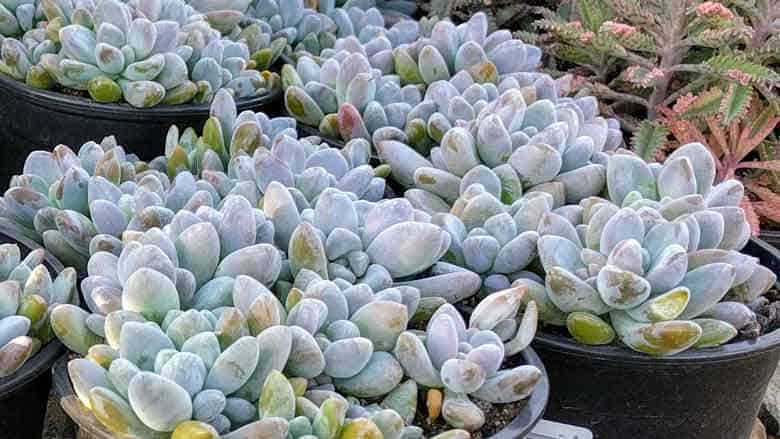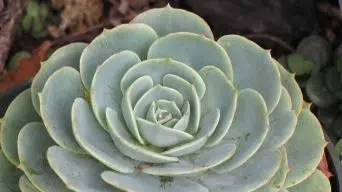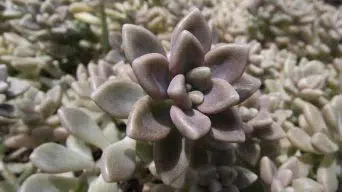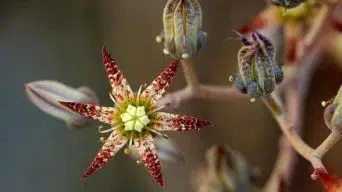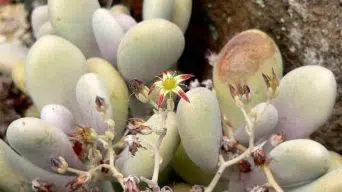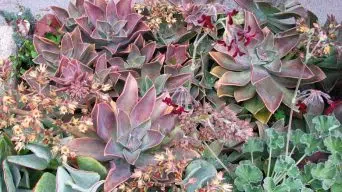Succulents are a popular choice for gardeners because of their drought-resistant properties.
However, many people don’t know how to care for them properly – or what they should do if the succulent is not thriving.
This guide will teach you how to propagate and take care of your Graptosedum ‘Blue Giant’ plant.
The Graptosedum ‘Blue Giant’ Succulent
The Graptosedum ‘Blue Giant’, also known as Sedeveria ‘Blue Giant’, is a hybrid of Graptopetalum amethystinum and Sedum treleasei.
The succulent has fleshy blue-green leaves that are tortoise-shaped. It can grow up to one foot tall and wide, depending on the amount of sun it receives.
The Graptosedum ‘Blue Giant’ plant is a slow-growing succulent that blooms yellow flowers in the spring.
How To Take Care Of a Blue Giant Succulent
Sun Exposure & Light Requirements
The Blue Giant prefers bright indirect light. They need at least four hours of direct sunlight per day to thrive and maintain their blue coloration.
But they can often be found in the shadier spots, just not on a windowsill that catches maximum midday sun.
If you have it where you want to grow your plant indoors, try placing them near a window with some natural or artificial partial shade.
You will know when they are getting too much sun if the leaves start turning purple-brown instead of green.
This is because prolonged exposure to intense heat causes leaf wilting due to dehydration from increased water loss through evapotranspiration via stomata pores on the surface of each leaf cell.
Watering
The Graptosedum ‘Blue Giant’ Succulent plant is a drought-tolerant succulent that thrives in desert-like conditions.
They thrive with little to no water and should be watered sparingly only when the soil has dried out completely. Overwatering this plant can cause rot or fungal issues as well as encourage leaf shedding.
Once a month is usually enough water for the plant. Still, if your soil is very dry and you’re having problems with leaf shedding, watering may be necessary more often.
Watering should only happen when all excess liquid has been absorbed to avoid wetting leaves touching the pot’s surface.
Be sure never to use cold or freezing water on this succulent, as it can cause tissue damage.
When they need to be watered, allow the top of the soil to become fairly dry before watering again. Leave them unwatered for at least one week during hotter months or two weeks if cooler weather persists.
When it needs to be watered more frequently, make sure not to overwater as this can lead to root rot, eventually killing your plant.
Soil
The soil that is used for this succulent should be well-draining and rich in organic matter.
When the soil does not have any of these qualities, it can quickly become “sour” or acidic. This will cause your plant to stop growing and may eventually kill it.
When repot the Blue Giant succulent, add some garden loam, peat moss, pine bark mulch, or leaf mold from deciduous trees. You could also add cow manure or aged compost.
You want a mixture that drains easily but still maintains moisture around roots, so keep an eye on how long it takes before water starts to drain out of the pot and water accordingly.
Temperature and Humidity
One of the most important factors in succulent care is temperature.
The Graptosedum ‘Blue Giant’ will thrive for a few hours if it’s kept at room temperature. Still, ideally, you want to keep them between 65 and 80 degrees Fahrenheit.
Store your plant in a cool spot to protect it from excessively cold or hot temperatures. It can be an unheated garage when the temperature drops below 68 degrees F and bring it inside if the temperature rises above 100 degrees F.
The optimum humidity for the Graptosedum ‘Blue Giant’ is 40-60% relative humidity.
To keep your plant healthy, it’s important to frequently mist its leaves with water. This will increase the humidity around it and provide nutrients to its leaves.
Fertilizing
The soil where the Blue Giant succulent grows should be well-drained and free of root competition.
If possible, remove any staked plants from around your Graptosedum ‘Blue Giant’ Succulent as they will use nutrients that would otherwise have gone to your plant.
This can mean a difference between life or death for many cacti and other succulents.
We recommend using organic fertilizers such as bone meal on all types of garden beds (including containers) at least three times per year during the spring months for more vigorous growth.
The best time to apply fertilizer is when you are doing an initial planting to have plenty of food available. At the same time, its roots establish themselves in the ground.
Potting and Repotting
Graptosedum ‘Blue Giant’ plants grow best when planted in a pot with drainage holes because the soil will dry out fast if left to sit too long.
The pot should have a hole in the bottom to allow for water drainage. The pot’s size depends on the size of your Graptosedum ‘Blue Giant’ plant.
A larger pot is necessary if there are multiple plants and they’re growing close together because succulents require more room than other indoor plants.
Graptosedum plants can go straight from a succulent garden into an outdoor planter.
Still, it’s best to repot them before winter so that their roots don’t freeze when temperatures drop below freezing and then start again next spring.
The best time of year to repot Graptosedum ‘Blue Giant’ is in spring, when they’re actively growing and not blooming. The soil can be left slightly on top or around the sides so that new roots will grow into it from below.
Fill your new pot with well-draining cactus mix soil.
The plant mustn’t be root-bound before moving them because this could make them more susceptible to shock after transplanting.
Be sure to use plenty of high-quality organic material like sphagnum peat moss or perlite to provide aeration and space for root growth.
Pruning
Pruning is important for two reasons.
It allows succulents to grow larger and healthier because it forces them to produce new leaves, which are the plants’ way of capturing light energy.
It also encourages branching, so if you’re propagating by stem cuttings (see below), a pruned cutting will have more branches.
The best time to prune your blue giant is in late winter or early spring before any new growth starts appearing on the plant’s stems, usually between March and May.
Use sharp shears or clean scissors to remove all dead, damaged, diseased, or pest-ridden material from the plant. Remove about one-third of the leafy tips of the plant.
Don’t worry, this won’t kill it! You can also clip off the individual leaves you don’t want if they’re not part of a healthy branch.
Before pruning your blue giant, make sure to inspect the stem for insects or other pests and trim them away with sharp shears as well.
If any disease is present on the stems, remove all diseased material from both ends of the stem before proceeding.
You’ll need clean tools for every cut you make so bacteria doesn’t spread further into your succulent tissue.
Pests and Diseases
Aphids and spider mites can be a problem for succulents in general.
These pests are not particular to the Graptosedum ‘Blue Giant’ Succulent plant. Still, they may become problematic if ignored over time.
If you have aphids, use insecticidal soap spray on the leaves to kill them. This is safe enough, even for plants with sensitive skin like this one!
Spider mite damage usually starts at leaf tips, which turn brown before other leaf parts follow suit.
However, it can take weeks before these symptoms appear. In order to prevent them from multiplying, it is best to address them as soon as you see the first signs.
It may also be a good idea to wash your Graptosedum ‘Blue Giant’ Succulent leaves with water occasionally (with care) and spray plants with insecticidal soap every few weeks during spring or summer.
If these pests are not taken care of quickly enough, they can cause leaf tips to turn brown before other parts of the leaf follow suit.
However, this can take up to two weeks before symptoms appear. To slow down their multiplication, you must immediately address any signs of pest damage.
A common disease that can affect Graptosedum ‘Blue Giant’ plants is leaf spot. This disease has dark brown or black spots on the leaves, which grow more prominent as time passes.
In order to prevent this from happening, water your plant only when it’s dry and fertilize it annually with a controlled-release fertilizer.
How To Propagate a Graptosedum ‘Blue Giant’ Succulent Plant
The Blue Giant Succulent can be propagated in three ways.
Stem Cuttings
Cut a branch from the Blue Giant Succulent plant that is one to two inches long and has at least one or more leaf nodes, then leave it in water for about four days until you see signs of rooting.
Gently pot up the rooted stem cuttings when fully grown into individual pots filled with potting mix.
You can also use sand as an alternative medium since succulents like dry roots.
Place them near a window so they get plenty of bright light but not too much heat from direct sunlight, which may scorch leaves and stems, though these plants prefer low levels of indirect sun exposure best.
Tubers
The Blue Giant Succulent can also be propagated by taking a bulb or tuber from the plant and planting it in well-draining soil.
The tubers will grow into new plants, which are clones of the parent.
Seeds
A third way to propagate your Blue Giant succulents is through seeds.
Plant them outside during spring, with about two inches between each seed.
Provide enough water so they don’t dry out but not too much that their leaves rot from over-saturation. The seeds will take about a month to germinate, so be patient.
Since they are drought-tolerant plants, you don’t need any additional water once the seedlings have sprouted.
The soil should remain dry for most of the winter but can get watered more often during spring, summer, and autumn.
When these easy-to-grow succulents become too big for their potting containers, give them plenty of space to grow. Transplant them into larger pots with fresh soil that has been well-draining.
Toxicity
The Graptosedum ‘Blue Giant’ succulent is not toxic and should be safe to have around pets or children.
However, it is a good idea to put the plant on its own table that your pet can’t access for safety reasons.
While this plant is not known to be toxic, it may irritate the skin.
If you have sensitive skin or low tolerance for allergens of any kind, we recommend wearing gloves when handling and planting your Graptosedum.
Final Thoughts
The Graptosedum ‘Blue Giant’ Succulent is an easy plant to care for and can be propagated with ease. It thrives in hot, dry climates as well as humid environments.
It is an excellent plant for beginners to have.

